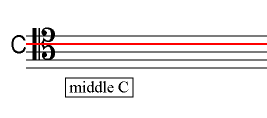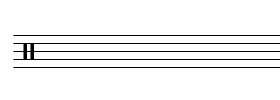Soprano & Mezzo-Soprano Clefs :: 
We begin by reminding you of the position of the three clefs that we met first in lesson 1. They are the treble, bass and alto clefs.

The treble clef marks the G above middle C on the second line from the bottom of the five line stave, the alto clef marks middle C as the centre line on the five line stave, and the bass clef marks the F below middle C as the second line from the top of the five line stave.
Notation in any field should be intuitive, clear and easy to follow. As we have already noted, when the musical line goes above or below the five lines of the stave we use leger lines to mark their pitch. It is easy enough to read at speed one or two leger lines but the performer is prone to greater and greater error the further one moves away from the stave. Also, the greater the space taken by each musical line to accommodate large numbers of leger lines the more inefficient in terms of space the notation becomes. The introduction of clef signs allowed composers to set the music mainly within the five lines and four spaces of a stave. Changes of clef within the musical line could also accommodate passages that might otherwise call for a lot of leger lines. Vocal lines, in particular, while narrow in range, were more economically notated by using special clefs. We have already met the alto clef which is a C clef (i.e. a clef that sets the note middle C). It was used formerly for the alto voice but today it is most commonly found in music for the viola. The soprano clef, setting middle C on the bottom line of the five line stave, and the mezzo-soprano clef, setting middle C on the second from the bottom line of the five line stave, were two other 'vocal' clefs.


The tenor clef is used to avoid excessive leger lines when notating very high passages for instruments that normally have their parts written in bass clef. The tenor clef was employed for the tenor voice, although today it is more commonly found in music for the larger tenor and bass viols, some brass instruments (e.g. tenor trombone) and when playing higher notes on the violoncello or bass. The clef is also required for playing much of the bassoon repertoire (thanks to Christopher Rosevear for e-mailing us about this).
In this clef middle C is placed on the second line from the top of the five line stave.

The bass clef, an F clef, also has two varients called the baritone and subbass clefs.
The baritone clef sets F below middle F on the 3rd line of a five line stave, while the subbass clef sets the F below middle C on the 5th line of the five line stave.


There is an alternative baritone clef employing the C clef placed on the top line of the staff.

In the seventeenth and eighteenth centuries, a special clef was used for violin music, particularly that published in France. For this reason it is known as the 'French Violin Clef' or 'French Clef' although it was even more commonly used for flute music. Being a G clef rather than a C clef, it sets the position of the G above middle C - in this case, on the bottom line of the five line stave.

Even with the freedom to move C, G and even F clefs around on the five line stave, you will find occasions when the musical line is still too high or too low to fit neatly onto the five line stave. A useful device that overcomes this problem is one that moves the musical line up or down an octave. The music is read as though at one octave but sounds either an octave higher or an octave lower than it is written. This can be done with any of the three clef signs (the C, F and G), placed in any position on the stave. We have illustrated some in the chart below.
 |
 |  |  |  |  |  |
| octave up G clef | octave down G clef vocal tenor clef | octave down double treble clef | octave up F clef | octave down F clef | two octave up C clef | two octave up F clef |
It should be mentioned that while the use of these kind of clef signs is 'good practice' many editions ignore the additional figure 8 or 15 and use the plain sign without the figure which is then 'understood'.
Where the pitch of notes is indeterminate as with untuned percussion special clef signs are used. We illustrate them below.


With percussion writing you will find composers using staves with anything from one to five lines. Single lines will refer to a named individual percussion instrument while multiple line staves will assign specific instruments to various lines which makes it easier for percussionists to play many instruments at the same time, for example, drummers playing on drum kits which include cymbals, side drums and bass drum, all in use at the same time.
We summarise below the clefs that are most often used today.


G-clef (e.g. treble clef) marks G above middle C also shown with a red line ----
C-clef (e.g. alto clef) marks middle C also shown with a blue line ----
F-clef (e.g. bass clef) marks F below middle C also shown with a green line ----